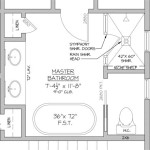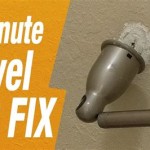Clearing a Blocked Bathroom Sink: A Comprehensive Guide
A clogged bathroom sink is a common household nuisance that can disrupt daily routines. It typically manifests as slow draining or a complete inability of water to drain, leading to standing water and potential hygiene concerns. Understanding the causes of these blockages and knowing how to address them is crucial for maintaining a functional and sanitary bathroom environment. This article provides a detailed guide to identifying the causes of a blocked bathroom sink and outlines several effective methods for clearing the obstruction.
The primary culprits behind bathroom sink blockages often consist of a combination of everyday items that find their way into the drain. Hair, soap scum, toothpaste residue, and small debris accumulate over time, creating a sticky mass that constricts the flow of water. These substances, when combined with the natural build-up of mineral deposits from hard water, can form a stubborn blockage that resists simple flushing.
Preventing sink blockages is always preferable to dealing with them. Implementing preventative measures, such as using drain strainers to catch hair and debris, can significantly reduce the frequency of clogs. Regularly flushing the drain with hot water can help to dissolve soap scum and prevent build-up. Moreover, avoiding the disposal of grease, oil, and other non-water-soluble substances down the drain is essential to maintaining a clear plumbing system.
Identifying the Source and Severity of the Blockage
Before attempting any clearing methods, it's important to assess the severity of the blockage and attempt to identify its location. Observe how slowly the water is draining. A completely stopped drain indicates a more severe blockage, potentially located deeper within the plumbing system. A slow drain suggests a partial blockage, possibly closer to the surface.
Examine the drain opening for any visible obstructions, such as clumps of hair or large pieces of debris. Removing these visible obstructions can often resolve minor blockages. Consider the recent usage of the sink. Has anything unusual been disposed of down the drain recently? This information can provide clues about the nature of the blockage and guide the choice of clearing method.
If the sink in question is part of a double vanity setup, check the other sink's drain. If both sinks are draining slowly, the blockage might be located further down the drainage line, affecting both sinks simultaneously. This scenario may require more advanced plumbing techniques or professional assistance.
Employing Basic Clearing Methods
Many sink blockages can be resolved with simple tools and readily available household items. The following methods are generally safe for most plumbing systems and should be attempted before resorting to more aggressive techniques.
Hot Water Flush: This is the simplest and often the first method to try. Boil a kettle of water and carefully pour it down the drain. The hot water can help to dissolve soap scum and loosen minor blockages. Avoid using boiling water on PVC pipes, as it can potentially damage them. Instead, use very hot tap water.
Baking Soda and Vinegar: This classic combination creates a chemical reaction that can break down grease and other organic matter. Pour about one cup of baking soda down the drain, followed by one cup of vinegar. Let the mixture fizz for 30 minutes, then flush with hot water. The bubbling action helps to dislodge the blockage and clean the drain pipes.
Plunger: A standard cup plunger or a flange plunger (better for toilets but usable on sinks) can create suction to dislodge blockages. Ensure there is enough water in the sink to cover the cup of the plunger. Create a tight seal around the drain opening and vigorously plunge up and down for several minutes. Remove the plunger and check if the water drains. Repeat as necessary. If the sink has an overflow drain, cover it with a damp cloth to maintain suction.
Wire Coat Hanger: Straighten a wire coat hanger, leaving a small hook at the end. Carefully insert the hanger into the drain opening and probe for any visible obstructions. Gently pull out any hair or debris that you encounter. Be cautious not to push the blockage further down the drain. This method is effective for removing surface-level obstructions but may not reach deeper blockages.
Advanced Clearing Techniques
If the basic methods fail to clear the blockage, more advanced techniques may be necessary. These methods often involve disassembling parts of the plumbing system and require some familiarity with basic plumbing procedures.
P-Trap Removal: The P-trap is the curved section of pipe located beneath the sink. It is designed to trap debris and prevent sewer gases from entering the bathroom. Over time, debris can accumulate in the P-trap, causing a blockage. Place a bucket under the P-trap to catch any water. Loosen the slip nuts that connect the P-trap to the drain pipes. Carefully remove the P-trap and clean out any debris that you find inside. Reassemble the P-trap, ensuring that the slip nuts are tightened securely. Run water to check for leaks.
Drain Snake (Auger): A drain snake, also known as an auger, is a flexible tool designed to reach deeper into drain pipes and break up or retrieve blockages. Insert the end of the snake into the drain opening and feed it through the pipe, rotating the handle as you go. When you encounter an obstruction, continue rotating the handle to break up the blockage or hook it and pull it out. Slowly retract the snake, cleaning off any debris that you retrieve. Run water to check if the drain is clear. Drain snakes come in various lengths and thicknesses; choose one appropriate for the size of the drain pipe.
Chemical Drain Cleaners: While readily available, chemical drain cleaners should be used with caution. They contain harsh chemicals that can damage pipes, especially older or corroded pipes. They can also pose a health risk if not handled properly. If using a chemical drain cleaner, follow the manufacturer's instructions carefully. Wear gloves and eye protection. Avoid mixing different types of drain cleaners. If the drain remains blocked after using a chemical drain cleaner, consult a professional plumber. The chemical residue can make it difficult and dangerous for plumbers to work on the drain.
Wet/Dry Vacuum: A wet/dry vacuum can be used to suck out blockages from the drain. Remove the drain stopper and create a tight seal around the drain opening with the vacuum hose. Turn on the vacuum and attempt to suck out any debris. This method is most effective for loose blockages or when combined with other clearing methods. Be sure to empty the vacuum canister after use.
After attempting any of these methods, it is important to thoroughly flush the drain with hot water to ensure that all debris has been removed and that the drain is flowing freely. Check for leaks around any connections that were loosened or disassembled. If the blockage persists despite these efforts, it is advisable to seek professional assistance from a qualified plumber.
Preventative Measures for Maintaining a Clear Drain
Preventing blockages is the most effective way to avoid the inconvenience and potential cost of dealing with a clogged bathroom sink. Implementing a few simple preventative measures can significantly reduce the likelihood of future problems.
Use Drain Strainers: Install drain strainers in the sink to catch hair, soap scum, and other debris before they enter the drain pipes. These strainers are inexpensive and easy to install. They require regular cleaning to remain effective.
Regular Hot Water Flushes: Periodically flushing the drain with hot water can help to dissolve soap scum and prevent build-up. Run hot water down the drain for several minutes each week.
Avoid Disposing of Grease and Oil: Never pour grease, oil, or other non-water-soluble substances down the drain. These substances can solidify and cling to the sides of the pipes, attracting other debris and forming a stubborn blockage. Dispose of grease and oil in a separate container and discard it in the trash.
Regular Drain Cleaning: Consider using a natural drain cleaner, such as baking soda and vinegar, on a regular basis to keep the drain pipes clear. This can help to prevent build-up and maintain a healthy plumbing system.
Professional Plumbing Inspection: Schedule a regular plumbing inspection to identify any potential problems before they become major issues. A professional plumber can inspect the drain pipes and identify any areas of concern, such as corroded pipes or potential blockages.
By understanding the causes of bathroom sink blockages and implementing these clearing methods and preventative measures, homeowners can maintain a functional and sanitary bathroom environment and avoid the frustration of dealing with clogged drains.

5 Natural Ways To Unclog A Bathroom Sink Hiller How

How To Unclog A Sink The Right Way

How To Unclog A Bathroom Sink Hana S Happy Home
How To Unclog A Sink 4 Easy Ways

How To Unclog A Slow Running Bathroom Sink Drain 10 Options

How To Unclog A Slow Running Bathroom Sink Drain 10 Options

How To Unclog A Bathroom Sink

How To Unblock A Bathroom Sink City

How To Unblock A Sink In 10 Steps Big Bathroom

How To Clear A Clogged Drain Reviews By Wirecutter
Related Posts







